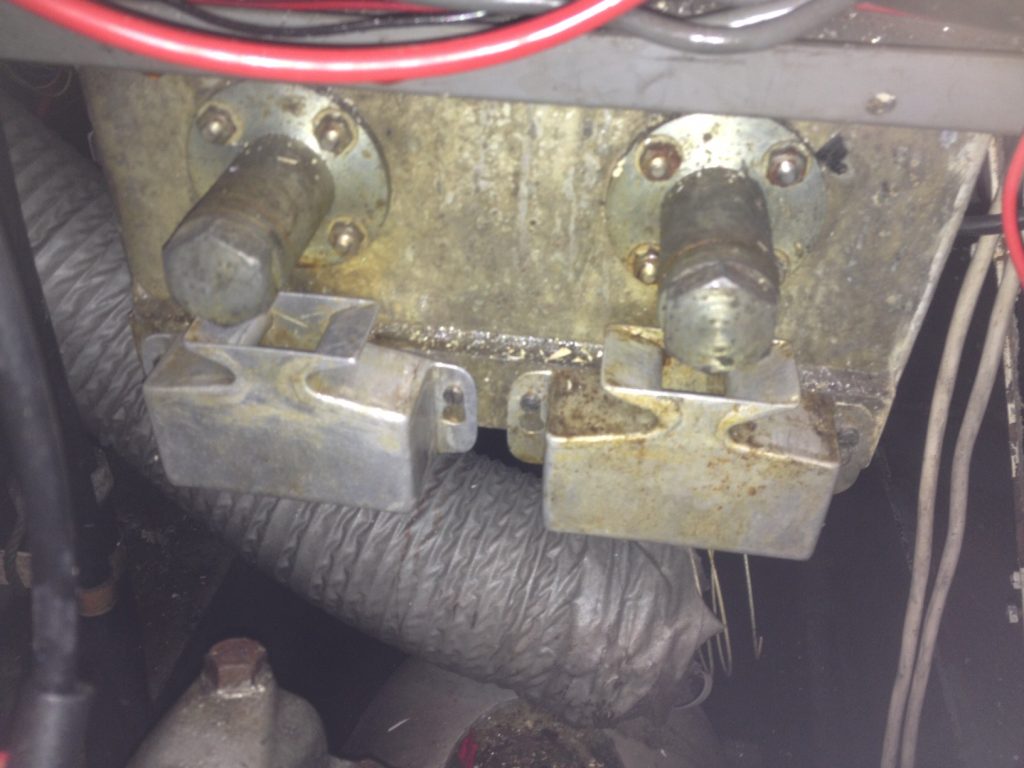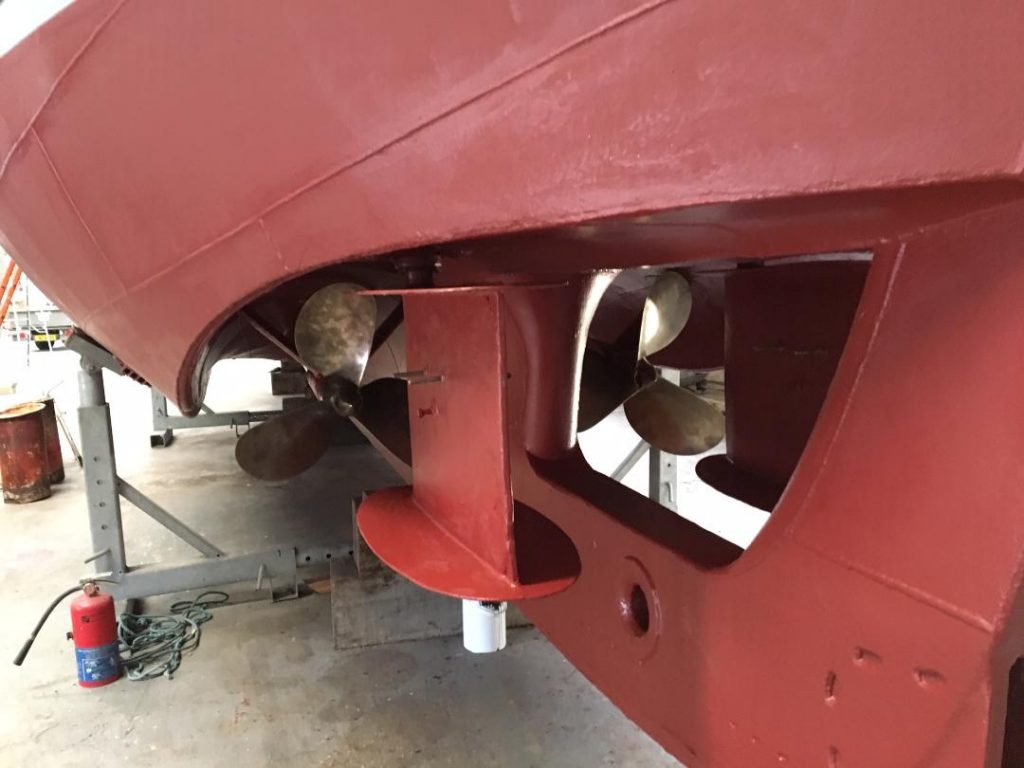All of the total sixteen combined 48’6″ Oakley and Solent Class lifeboats built, starting with the magnificent aft wheelhouse configured ON968, 48-01, ” The Earl And Countess Howe” of 1963 to the splendid final Solent Class lifeboat, ON1021, 48-016, “Douglas Currie” of 1973 were fitted with a fabulous matched pair of contra rotating Gardner 6LX Diesel engines, Gardner 2UC Reversing Gearboxes and 2:1 Reduction Boxes. These drive via 2 1/2″ stainless steel shafts a pair of 28″ diameter x 31 1/2″ course pitch bronze propellors which are located onto the shaft via a taper, key and streamlined bronze tail nut locked in place by a pair of stainless steel 1/4″BSF x 7/8″ long hex headed bolts. The propellors contra rotate outwards and upwards from the centre keel apart from on ON1013, 48-010, “The Royal British Legion Jubilee” which on trials proved to be particularly reluctant to hold a steady course through the water and consequently she was initially rejected by the RNLI, engineers had her machinery swapped over from port to starboard to effect an inward turning pair of props for a possible improvement in straight line cruising, it is assumed that it was effective to some degree as she did enter RNLI service after a naming ceremony by H.M. The Queen at Henley on Thames in 1972. (In December of 2020 ON1013 was sadly broken up after her owner couldn’t find a buyer for her, the engines were bought by a guy in Scotland and we were lucky enough thanks to Derek’s hard work to be able to buy the original Wynn windscreen wipers the double front unit and one of the missing rear units to replace those previously removed from ON1008, additionally Derek was able to buy the missing vent units with capsize valves, the hydraulic windlass winch and the centre dash switch panel, all that are very welcome additions to the restoration.
The Gardner 6LX engines on the Oakley 48’6″ and Solent Class lifeboats are set for continuous full speed heavy duty use to each produce 110 B.H.P. at a maximum 1,300 R.P.M.. The 6LX engine has a capacity of 10,500cc (638 CUI), has an exceptional power to weight and power to space ratios, additionally it has a most efficient fuel consumption of 0.330 lb. /per b.h.p. /hour, this equates to a thermal efficiency of 39.73″ that could be increased to a full 40″ thermal efficiency if slightly below peak torque revolutions are employed.
The Gardner 6LX engine was first produced in 1958 and stayed in production for 40 years up until 1998. It was devised as an update for and would fit into the same size space and in fact used the same engine mountings as the earlier (1931 – 1976) and slightly less powerful 84 B.H.P., 8,369cc (511 CUI) 6LW engine.
In comparison to later high speed marine Diesel engines the BHP output for there Gardner engines seems comparatively low, but of course they were devised for very high pulling power even from very low revs and of course are very economical too. The Solent Class (and other Gardner engine equipped Lifeboats) will accelerate from stationary up to the full service speed of the displacement type hulls very rapidly. Although the top speed isn’t high on a Solent Class compared to later designs, this wasn’t a problem as the boats covered a relatively short range from each station that allowed them to effect rescues in as timely a manner as was required at the time. As RNLI policy changed to a fast fleet in the mid 1980’s, the slower large displacement Lifeboats were all phased out by 1993. But as we’ve seen many of the Solents joined foreign SAR organisations after RNLI service and continued to give great service, in one still doing so in 2020.
The 6LX engines on the Solent Class are cooled by a closed fresh water / glycol cooling system, the coolant of which is circulated by a high output centrifugal water pump mounted on the right hand side of each engine, via a pair of thermostats and pipework to a Serck heat exchanger for each engine in the after cooler compartment. (There is a cooler section attached for oil cooling on each engine too.). Each cooler is cooled by sea water that is drawn through a fwd grille and expelled through a rear grille by the movement of the hull through the water. The Serck heat exchangers are of a very high efficiency and in fact one could easily cool both engines but the RNLI doubled up both sets of ancillary equipment to ensure that hopefully one engine would be running even if one was disabled for any reason. On the Solent Class both exhaust system Burgess silencers are cooled by water jackets too which reduces heat and noise levels in the engine room. As well as the standard Gardner Marine 6LX coolant header tank, the RNLI specified and additional copper coolant tank feeding the header tank directly by gravity and additionally each exhaust cooling system has its own copper header tank too, nothing is lefty to chance.
Each engine is fitted with a coolant electrical pre-heating Bray Heater, this is the same technology as used in hot water tanks at home. This heater would be used on station (in boat house or afloat) to keep the engine coolant at operational temperature while the lifeboat’s engines were stopped and allowed the lifeboat to be launched and engage full power immediately on leaving the slipway which was vital, particularly on exposed stations in bad weather. Units are available for your car at home to achieve the same results on cold mornings, also this helps to keep engine wear to a minimum, bonus!
James And Mariska Joicey still has her original paired, contra – rotating Gardner 6LX engines;
Port Engine number is; 165100 + 2405OK2600
Stbd Engine number is; 165701 + 2256TK24341

Each engine holds around 25 litres of engine lubricating oil of straight 30 grade, we’re currently using Shell Gadinia 30 oil which we changed along with the filters in 2014 on recommissioning the engines and is currently on approximately 50 hours running time. We will run for this season and change the oil before the winter of 2021.
As mentioned earlier, Gardner 2UC unit construction gearboxes are fitted to the Oakley 48’6″ & Solent Class Lifeboat and have a reversing and reducing gearbox on which the changing from from forward to neutral to reverse and back is achieved by an hydraulic ram activated remotely along with the throttles via cables from a single Gardner control lever per engine mounted in the wheelhouse by the helm. On these boats the reduction gearbox is 2:1 ratio (direct drive and 3:1 ratios were available for different applications), so the propeller is turning at 50% of engine revolutions. The hydraulic gear change ram can be deactivated via a spin wheel valve if the engines need to be run at various revs without the propellers turning.
The propeller shafts within the stern tubes and associated white metal over bronze stern tube bearings are lubricated via hand grease pumps in the engine room with NEOX DT Grease from Vickers Oils of Leeds. There are other equivalents of this grease available but I have found Vickers Oils to provide an excellent service, the important factors are that the grease is suitable for shell type bearings and emulsifies well in sea water. Grease is pumped via pipes into the rear end of the stern tubes until it returns to the engine room and discharges into a pair of beautiful hand crafted grease collection vessels. The grease being pumped until it drips cleanly without any water present.

The propellor shafts approximately 24″ the gearboxes, pass through a substantial bronze bearing unit mounted on the after engine room bulkhead. These bearings are lubricated by drip feed via a small reservoir of engine oil. The rate of feed is adjustable via a valve in the reservoir. The bronze bearing units also form part of the watertight sealing of the bulkhead whist still permitting the shafts to pass through.
The previous owners of ON1008 had purchased a pair of automatic greasing & oiling units from Lubsite Systems Inc. based at that time in Kingston, North Carolina to enable the boat to be operated single handed without the need for an engineer. These new units had disappeared by the time I bought the boat and I’m quite happy to retain the original manual grease pumps and oil drip feeds which are working perfectly. I don’t plan any solo voyages beyond local manoeuvring so this won’t be an issue.
The bronze handed propellors are 28″ diameter x 31.5″ pitch and especially made for the RNLI to BS1935. For the trip from Co.Donegal we used ON1008’s original propellors but they were quite chipped and damaged on the tips of some blades, two on the starboard prop being particularly chewed up, most likely in attempts to get her back into deeper water when she was first beached at Moross. Subsequently we had to balance the engine revs to give the least vibration for that transit voyage on the stbd engine in particular. In 2015 we were able to purchase a cache of surplus spares for the boat from a fellow Solent Class owner and luckily included was a perfect pair of propellors that only needed a clean and polish before fitting. The props were originally fitted to the 48’6″ Oakley Mk2, ON1016, 48-13, “Princess Marina” which following what with hindsight has proven to be a misguided internal edict, was sadly broken up at Portishead in December 2003. We will, when funds allow, have the original propellors repaired and balanced to be used as replacements if required.



